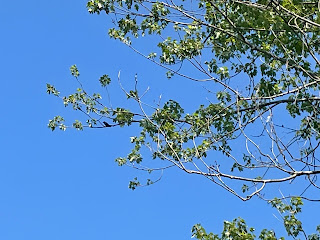NEW SPECIES
1. Flat-topped Goldenrod
Euthamia graminifolia
This common pollinator plant needs a lot of sun, which makes Mary's Meadow a good place for it to grow. It is a colony-forming wildflower that can grow in dry-moist soil. It can grow without a lot of encouragement. Some of the pollinators that will come to this plant include bees and butterflies.
New England Wild Flower Society (http://plantfinder.nativeplanttrust.org). (2022). Euthamia graminifolia. New England Wild Flower Society. Retrieved August 4, 2022, from https://plantfinder.nativeplanttrust.org/plant/Euthamia-graminifolia
2. Purple Crown-vetch
Securigera varia
Purple crown-vetch was first introduced to North America in the later 1800's from Europe, Asia and Africa. It was brought over as a ground cover plant to prevent erosion, but unfortunately has become quite invasive in open places in some places. The pretty flowers are irregular and pink.
Unfortunately, I did see a healthy amount of it in Mary's Meadow.
This is no surprise because Mary's Meadow does have a good amount of sun.
Minnesota Wildflowers. (2022). Securigera Varia (Crown Vetch). Minnesota Wildflowers. Retrieved August 4, 2022, from https://www.minnesotawildflowers.info/flower/crown-vetch
3. Wild Carrot
Daucus carota

Other names for Wild Carrot are Queen Anne's Lace and bird's nest. This plant originated in Europe and Asia and was introduced to North America as a root vegetable and medicinal herb. The root smells like carrots, hence the name. In some places this plant is considered an invasive plant. The habitat of Mary's Meadow is perfect for the Wild Carrot; as are road sides, pastures and prairies. It is not recommended to eat this plant because it looks similar to a deadly plant called Poison Hemlock. Handle with care as the sap can cause a rash when on the skin and exposed to sunlight.
Minnesota Department of Agriculture. (2022). Wild carrot. Wild Carrot. Retrieved August 4, 2022, from https://www.mda.state.mn.us/plants/pestmanagement/weedcontrol/noxiouslist/wildcarrot
4. Common yellowthroat
Geothlypis trichas
Photos are credited to:
Sanderson, R. (2020). Common Yellowthroat. The Cornell Lab All About Birds. Retrieved August 4, 2022, from https://www.allaboutbirds.org/guide/Common_Yellowthroat/photo-gallery/66117601.
The Common Yellowthroat is a smaller songbird in the New World Warbler family who makes its habitat in forest edges and fields, similar to Mary's Meadow, as well as shrubby wet areas and marshes. It's short rounded wings indicate that it is a short-distance migrant who doesn't go further than the southern united states and central America. The song of the Common Yellowthroat is similar to a "witchity-witchity-witchity" sound. The oldest Common Yellowthroat on record was 11 years old when it was caught and released in 2015 by a bird banding group in Massachusetts.
eBird. (2022). Common yellowthroat - ebird. Common Yellowthroat. Retrieved August 5, 2022, from https://ebird.org/species/comyel
Cornell University. (2n.d.). Common yellowthroat overview, all about birds, Cornell Lab of Ornithology. Overview, All About Birds, Cornell Lab of Ornithology. Retrieved August 4, 2022, from https://www.allaboutbirds.org/guide/Common_Yellowthroat/overview
REFLECTION:
It’s remarkable how it has become so easy to move through the day,
closed off,
unaware of the multitude of WiLd ThInGs
that abound and surround us.
SkY, WiNd, CrEaTuReS, WaTeR VaPoR...
It's like we’ve chosen an *alternate reality* of our own creation
instead of what is really real.
A control mechanism turned habit.
A plugging up our ears and saying “blah blah blah. I’m not listening.”
Countless lessons can be learned from the WiLd PlAnTs and CrEaTuReS.
L e t t i n g G o,
trusting,
and JOY that can come
despite life’s unpredictability,
just to name a few.
For the time I spend outdoors each day,
surrounded by the WiLd EaRtH,
I want to be truly PRESENT,
intentionally and keenly OBSERVANT.
a HUMBLE and receptive STUDENT,
appreciate my WiLd TeAcHeRs
for their subtle example of how to
GROW toward the sun,
OBSERVE their generosity with space,
CALM and SURRENDERING to what each day brings.
Because I am part of nature, may I seek,
like the rest of the natural world,
and reflect the Creator of Nature.
*QUESTION OF THE WEEK*
How might global climate change affect your ecosystem?
Describe some specific pressures or changes your ecosystem might experience.
***
The mosquitoes that have been prevalent in Mary's Meadow
will become even more numerable as a result of the longer times of heat during the year,
making spending time outside even more challenging.
Related, the increased temperatures will make spending time outside safely
less frequent which will mean
even greater amounts of separation from Nature.
Warmer summers will mean a lack of drinking water
or a lack of available water needed for growing crops in the summer months.
And while it might mean a longer growing period for crops,
it will also mean a longer growing period for invasive species
and plants that cause allergies.
The smaller mammals in Mary's Meadow who depend on the insulation that snow provides
may die out if there is less snow precipitation,
which will impact the animals that depend on them for food.
Currently the Field Sparrow, who I heard in Mary's Meadow,
is a species of high vulnerability
due to climate change.





.jpg)














































